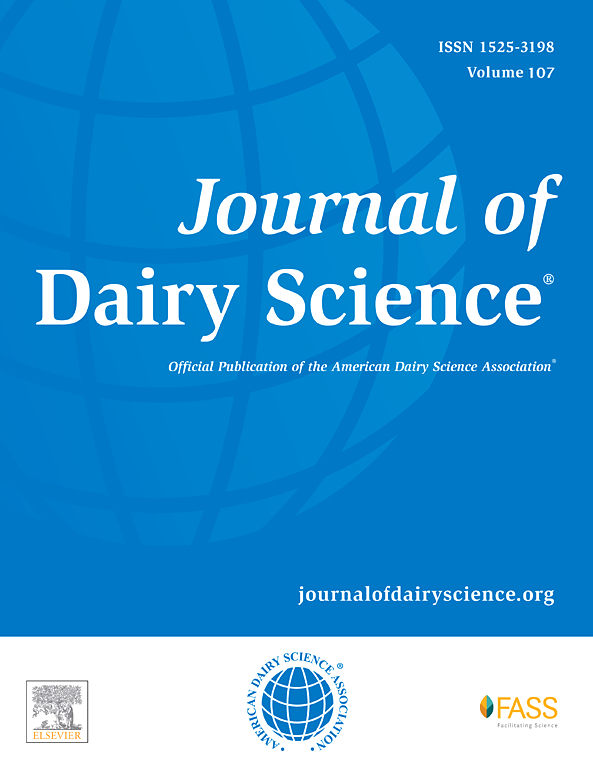Effects of animal rennet, fermentation-produced chymosin, and microbial coagulants on bovine milk coagulation properties
IF 3.7
1区 农林科学
Q1 AGRICULTURE, DAIRY & ANIMAL SCIENCE
引用次数: 0
Abstract
Coagulants play a crucial role in cheese production by catalyzing milk curdling, with traditional animal rennet long serving as the primary choice. However, due to cost, availability, and ethical concerns, various substitutes such as microbial coagulants and fermentation-produced chymosin (FPC) have emerged. This study aimed to evaluate the effects of 8 commercial coagulants, including 1 bovine rennet, 2 bovine FPC, 1 camel FPC, 3 microbial (i.e., Rhizomucor miehei) coagulants, and 1 bovine FPC variant, on the coagulation properties of bovine milk. The coagulants were tested at 3 different doses (35, 50, and 65 international milk clotting units per liter) across 8 batches of unhomogenized, pasteurized, full-fat, bovine milk purchased from different commercial brands, in 2 replicates, for a total of 384 coagulation analyses (8 milk batches × 8 coagulants × 3 doses × 2 replicates). Specifically, traditional milk coagulation properties and curd firmness at given times were assessed using a lactodynamograph. Key findings indicated significant variations in coagulation patterns across the coagulants. Bovine rennet demonstrated an intermediate coagulation profile among all FPC and microbial coagulants. The bovine and camel FPC exhibited faster coagulation than the bovine animal rennet, with the camel FPC showing the quickest coagulation and curd-firming rates. The microbial coagulants, although exhibiting slower coagulation rates for a given dose, produced curd-firming dynamics different from those of all FPC. The bovine FPC variant exhibited high performance comparable to that of the camel FPC in the coagulation process. Overall, this study highlights the distinct coagulation characteristics of various coagulants, offering insights into their suitability for different cheese-making applications. The coagulant dose significantly affected the coagulation pattern, with a clear linear increase in dose influencing gelation and varying effects on other coagulation traits. These findings can guide producers in selecting the optimal coagulant and dose based on specific cheese production needs.
动物凝乳酶、发酵产凝乳酶和微生物凝固剂对牛乳凝固特性的影响。
混凝剂通过催化牛奶凝固在奶酪生产中起着至关重要的作用,传统的动物凝乳酶一直是首选。然而,由于成本、可获得性和伦理方面的考虑,各种替代品如微生物凝血剂和发酵产生的凝血酶(FPC)已经出现。本研究旨在评价8种商品混凝剂,包括1种牛凝乳酶、2种牛FPC、1种骆驼FPC、3种微生物(如米黑根)混凝剂和1种牛FPC变体对牛乳凝固性能的影响。在8批次不同商业品牌的未均质、巴氏消毒的全脂牛奶中,以3种不同剂量(35、50和65国际牛奶凝血单位/升)对凝血剂进行了测试,共进行了384次凝血分析(8批次牛奶× 8种凝血剂× 3种剂量× 2个重复)。具体地说,传统的牛奶凝固特性和凝乳硬度在给定时间使用乳动力仪进行评估。主要研究结果表明,不同凝血剂的凝血模式存在显著差异。牛凝血酶在所有FPC和微生物凝血剂中表现出中间凝血特性。牛和骆驼FPC的凝血速度均快于牛动物凝血酶,其中骆驼FPC的凝血和凝乳速度最快。微生物凝血剂虽然在一定剂量下表现出较慢的凝血速率,但产生的凝乳凝固动力学不同于所有FPC。牛FPC变体在凝固过程中表现出与骆驼FPC相当的高性能。总的来说,这项研究突出了不同混凝剂的不同凝血特性,为它们在不同奶酪制作应用中的适用性提供了见解。混凝剂剂量显著影响凝血模式,剂量的增加对凝胶的影响呈明显的线性增加,对其他凝血特性的影响也各不相同。这些发现可以指导生产者根据特定的奶酪生产需要选择最佳的混凝剂和剂量。
本文章由计算机程序翻译,如有差异,请以英文原文为准。
求助全文
约1分钟内获得全文
求助全文
来源期刊

Journal of Dairy Science
农林科学-奶制品与动物科学
CiteScore
7.90
自引率
17.10%
发文量
784
审稿时长
4.2 months
期刊介绍:
The official journal of the American Dairy Science Association®, Journal of Dairy Science® (JDS) is the leading peer-reviewed general dairy research journal in the world. JDS readers represent education, industry, and government agencies in more than 70 countries with interests in biochemistry, breeding, economics, engineering, environment, food science, genetics, microbiology, nutrition, pathology, physiology, processing, public health, quality assurance, and sanitation.
 求助内容:
求助内容: 应助结果提醒方式:
应助结果提醒方式:


